Moss has been around for more than 300 million years. It forms dense carpets of green on the ground and is usually found on forest floors in moist and warm environments. However, it can also sometimes invade lawns. Typically, the reason for this is struggling grass. Keep reading and let’s talk about moss in lawn.
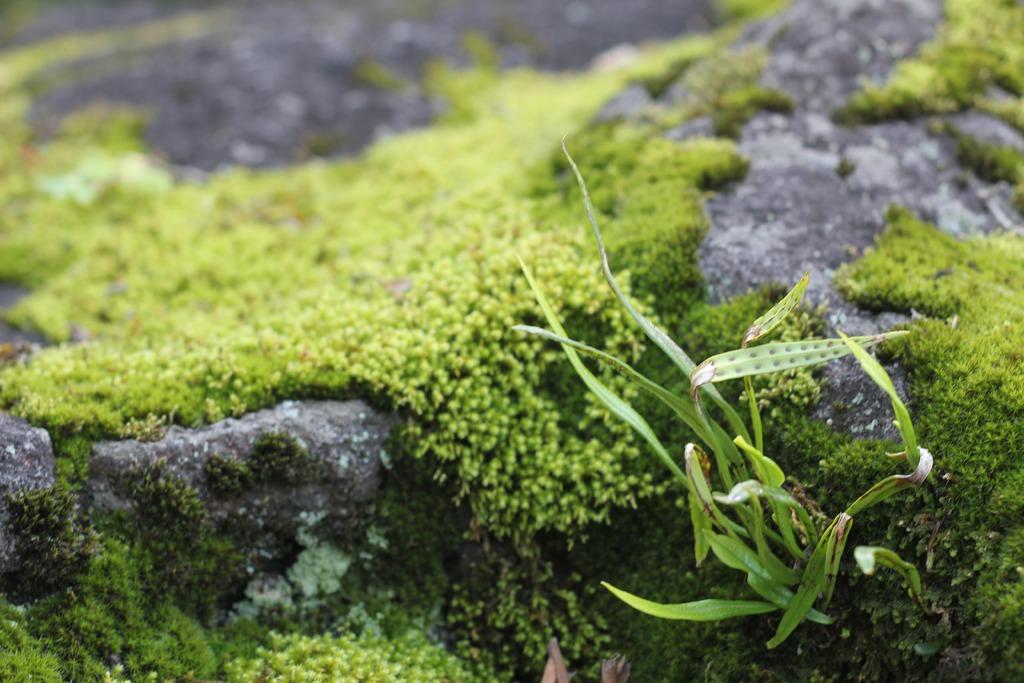
Moss looks nice and green, but it could smother your grass.
Almost all gardens have problems with moss at some stage. Initially, moss looks good and might add a bit of freshness and green to your lawn. However, these miniature plants will soon take over your yard and turn it into a fuzz. Removing moss from a yard is not difficult; however, it is only part of the solution.
For complete control, you must also ensure that moss does not come back to your lawn.
How can you do that? Please read to find out!
What Is Lawn Moss?

Mosses are small, non-vascular flowerless plants in the taxonomic division of Bryophyta.
Let’s start with the most basic question. What exactly is lawn moss?
Successful moss control begins with understanding that moss is not like other lawn weeds. Moss dates back to prehistoric times, and it has mostly stayed the same since then. These miniature plants do not process nutrients and water like other plants.
It is because mosses are non-vascular plants, meaning they do not have roots. Therefore, even the most potent weed killers will typically not work on moss.
Furthermore, they reproduce by spores, and thousands of different moss species exist.
Lawn Moss Appearance
As already stated, there are thousands of different moss species, and many of them will invade lawns and gardens if given a chance and the right conditions.
So, depending on the species, they will look slightly different.
Nevertheless, all mosses have identical body symmetry. They are a few centimeters tall and across in size. Typically, they appear on lawns as coarse, small, and green to yellow tufts between the grass and look somewhat fuzzy and spongy.
However, mosses can also form a dense mat of green vegetation on the ground in case of a severe infestation. There is also this moss species, Polytrichum. It has a unique look and appears like a tiny forest of small Christmas trees on the ground.
Is Lawn Moss Dangerous To The Grass?
These pesky, miniature, prehistoric plants can appear uninvited on your lawn; however, they are not dangerous to your grass and will not overtake your property.
They will instead fill up places in your yard where the lawn is thin or patchy.
Many homeowners even purposefully incorporate moss in their lawns and backyards because of its green and unique appearance on the ground. However, your grass might be struggling if moss appears out of nowhere on your lawn.
It is because poor growing conditions favor the growth of moss. These include
- Acidic soil conditions
- Poorly prepared or poorly maintained lawns
- Impoverished yards or infertile soil
- Mowing too close
- Drought-stressed grass
- Wet weather and waterlogged conditions
- Compacted soil
- Shady areas, especially beneath trees
- Worn areas of turf, especially along walkways
- And, thin grass cover
Let’s now discuss some of these factors of moss growth in a bit of detail before we discuss their treatment, as getting rid of them is only part of the problem.
RELATED: How To Get Rid of Moss in Your Lawn Naturally | Expert Tips & Tricks
What Causes Moss In Home Lawns?
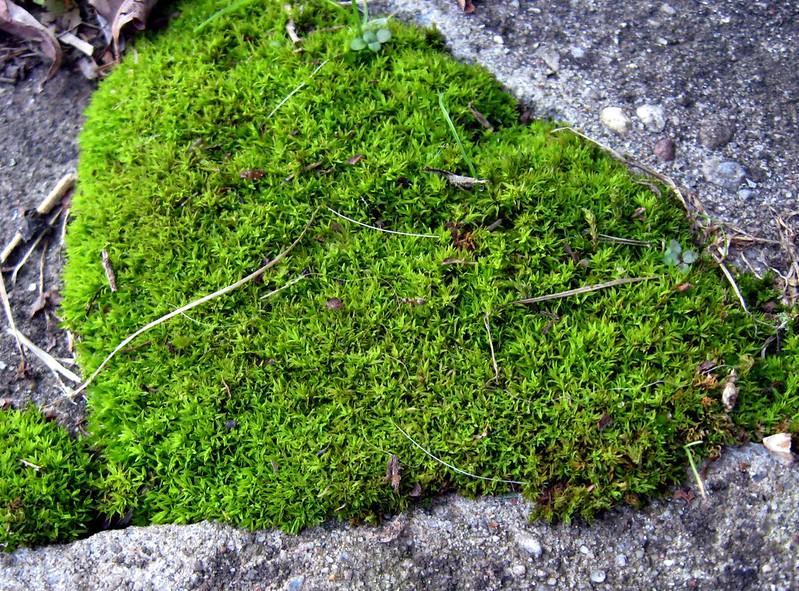
Poor lawn care practices often cause moss growth in yards more than anything else.
If you want to get rid of moss from your yard, you need to understand or figure out why it is there in the first place. Some of the reasons for moss growth on lawns have been mentioned above. And, you can see, nearly all of them are associated with lawn care.
Poor lawn care and grass health is the biggest reason for the appearance of moss on the lawn. You can temporarily eliminate moss, but it will reappear if you do not fix the underlying issues: the conditions causing moss growth in the first place.
So, let’s now look at some of the main factors that cause moss growth.
Improper Watering
If you have a lawn, you must know that grass does not grow well when it does receive adequate moisture. And that too much water can cause trouble too.
The wrong amount of water will weaken your grass and encourage moss growth in your yard. For example, when the lawn is under drought stress, it thins out in places that give the moss a chance to move in and take hold of your patchy turf.
Likewise, if your lawn suffers from overwatering or drainage issues, it will result in poor grass growth. It will also provide a chase to move in and establish itself in the yard.
Excessive Shade
If your lawn does not receive enough sunlight or large shady trees and buildings surround it, the moss might move in and start growing. Excessive shade favors moss more than grass.
And, since mosses are so good at succeeding in the shadow, some people even use them as an alternative to grass to create green spots around large buildings.
You may ask why mosses are so good at growing in the shade. It is because mosses are prehistoric and primitive plants. They do not have complicated biological systems like higher plants from today, including lawn grass and household plants.
So, they do not need much energy in the form of sunlight and do well in the shade.
Poor Soil Conditions
Poor soil conditions include many lawn problems such as soil compaction, lack of nutrients (low fertility soils), accumulation of thatch, lack of soil aeration, etc.
If the soil of a yard is in poor shape and does not have enough nutrients, it will not be able to support healthy grass. As a result, the turf on your property may get patchy in certain spots, allowing moss to move in and take hold of your yard.
Mosses can easily survive in compacted, rarely aerated, and low-fertility soils as they have short roots and very little water and nutrient requirements as plants.
Low pH Soil
Most turfgrass species generally need a pH level of anywhere between 6 to 7 to grow well. If the pH of your soil is lower or higher than the pH your turfgrass species need to survive, it will not grow well, and you will end up with thin or patchy turf.
However, moss does not have a problem growing in acidic soils. In fact, mosses prefer a soil pH range of 5.0 to 5.5. However, the statement does not mean they will only grow in acidic soils. They will also grow fine in alkaline soils.
Other Lawn Issues
Besides the problems mentioned above, numerous other lawn issues can cause moss growth in your yard. For example, any lawn fighting stress from disease, a pest, or a weed is likely to have weak or thin grass. And stressed grass cannot compete with moss.
Lastly, the lack of general lawn care is also a significant reason for the appearance of moss on lawns. Some common examples are: mowing irregularly, rarely fertilizing, and allowing thatch to build up in the yard. These things can also put grass under stress.
How To Get Rid Of Moss From A Lawn?
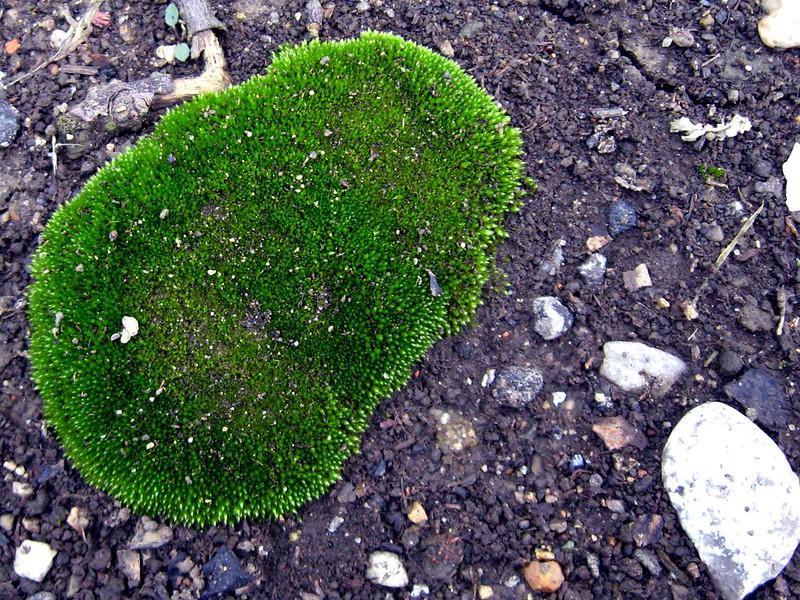
Are you dealing with moss in the yard? Please read the instructions below.
By now, you are probably well familiar with moss and why it appears on the grass.
So, now let’s get the ball rolling and see what you can do to remove moss from your lawn now that you have it. And do not worry! It is pretty straightforward.
When To Get Rid Of Moss?
Moss can be dealt with whenever it appears in your yard at any time of the year.
It is easy to remove temporarily. However, for permanent solutions that keep the moss from coming back, you will need to focus your efforts on the standard times for grass care.
These efforts often include changing the cultural conditions of your lawn and are best performed in spring and fall, depending on the grass species in your yard.
Moss Removal In Spring
Spring is one of the best times to remove moss from a lawn. Moss moss often invades lawns in the winter and begins to flourish along with other weeds in the spring.
Most people also perform major lawn maintenance activities during the spring, such as weed removal and tilling, etc., which makes it a great time to apply moss treatment.
Moss Removal In Fall/Autumn
For cold-season grasses, moss removal is best done in the fall months. It is because they are still recovering from the summer damage and need help to survive.
Therefore, removing moss in the autumn could help eliminate unnecessary competition from the moss, which would otherwise completely take over a thin turf.
Safety Considerations Before Removing Moss
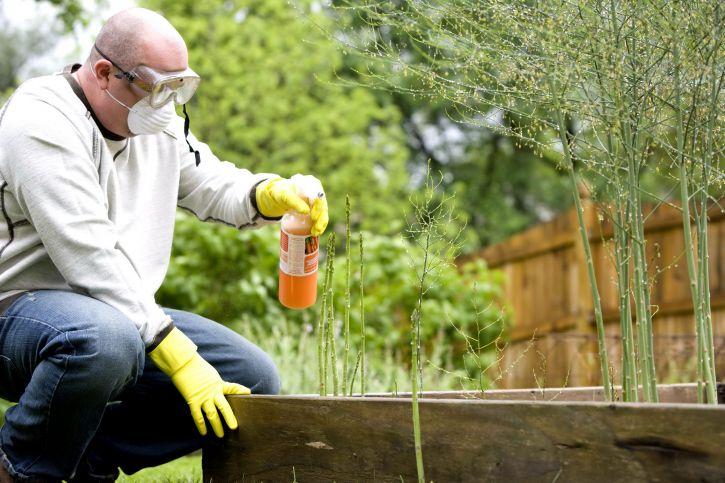
Know what you are doing before you start and put on proper safety equipment.
Before you start, please keep in mind that sometimes moss removal from a site may involve the use of chemical moss killers. And the ingredients in most commercially available moss killers often include ferrous ammonium sulfate and iron sulfate.
While these chemicals are not physiologically toxic like commonly used herbicides, they are corrosive. Moreover, they can irritate the skin and lungs if touched or inhaled. Lastly, these chemicals also severely threaten aquatic life in case of a runoff.
Therefore, when using moss killers on your property, ensure that you only use the required amount, stick with a spot treatment, and avoid spilling the chemicals.
Things You Will Need
Below are a few things you might need when removing moss from your lawn.
You might not need all these things, but you know what they say: it is better to have it and not need it than to need it and not have it.
- Baking soda
- Chemical moss killer
- Dethatching rake or power dethatcher
- Dish soap
- Garden (bow) rake
- Garden sprayer
- Lawn Fertilizer
- Pruning saw (where needed)
- Soil aerator (where required)
- Soil amendments (as recommended)
Step 1. Start With Raking Your Lawn
Moss has shallow roots, so you can simply rake it out. To do this, take either a leaf rake or a bow rake and pull the moss out. The tick will work best when the soil is moist.
Also, try raking from several angles, as it will loosen up the moss better.
Step 2. Spray With An Organic Solution
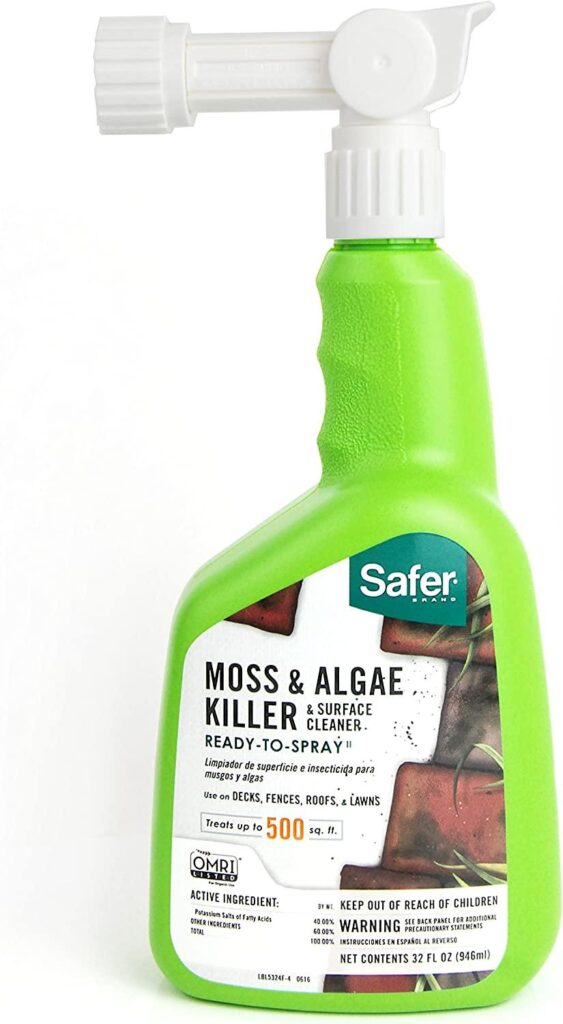
Safer Brand Moss and Algae Killer and Surface Cleaner, 32 oz. Hose Sprayer
While the quickest way to kill moss on a lawn is to use a commercial moss killer, you might also have some success with organic moss-killer solutions. These organic solutions are an excellent option for organic gardeners who avoid using synthetic chemicals.
There are several non-toxic and very effective organic remedies you can try.
For example, you can use baking soda to kill moss. To do this, fill a garden sprayer with about two gallons of warm water and add a pack of baking soda. Shake the sprayer bottle vigorously to mix things up. Then spray it on moss patches in your yard.
If you do not have baking soda, do not worry! You can also make a moss-killer solution with ordinary dish soap. To do this, add about five ounces of dishwashing soap to a gallon of water and stir well. Spray it on the moss, and soon it will be gone.
Lastly, several commercially available horticultural soaps can also kill moss in a lawn. My favorite among them is Safer Brand Moss and Algae Killer.
Step 3. Spray Will A Chemical Moss Killer
Sometimes the moss will not just disappear, no matter how much organic moss-killer solution you spray on it. Times like this necessitate the use of chemical moss killers.
Once again, though, ordinary weed killers designed to eliminate plant pests will not work on moss. You will have to get something specifically targeted at killing moss, such as products containing iron sulfate or ferrous ammonium sulfate.
Also, when using these products, follow the instructions on the label. These products are often labeled “moss killers.” Learn about the best moss killers around in this article.
However, remember that these chemical moss killers are by no means a permanent fix to the moss issue in your yard. As long as the problem causing the moss to grow in your lawn persists, moss will return to your property sooner or later.
Below are some suggestions on how you can do it. However, depending on the underlying issue in your lawn, you might need some other adjustments or changes.
RELATED: How Often Should I Fertilize My Lawn? A Quick & Easy Guide To Lawn Fertilization
Disposing Of Dead Moss
After successfully killing all the moss on your lawn, it is time to get rid of it.
It can be done in two ways: throw it or compost it. I usually go with the second one.
However, consider that composting moss takes relatively longer compared to other garden and kitchen waste types. Also, you must ensure that you mix it correctly with the other composting materials. In my experience, a ratio of 4:1 works the best.
How To Prevent Moss From Coming Back?
Now that you have successfully killed moss in your yard, the next step is to ensure it does not come back. To do this, first of all, determine the underlying issues causing moss.
Next, fix it, and you are good to go. Some of these issues and their fixes are as follows:
Remove Thatch & Aerate Your Yard

Aerating your lawn will relieve soil compaction and enhance grass growth.
Some lawn owners trying to remove moss from their lawns only need to eliminate thatch from their properties as it might be causing issues with drainage and water, air, and nutrient penetration into the soil to help support healthy grass growth.
You can dethatch your lawn yourself with a hand rake.
However, the job is often quite challenging and labor intensive. Therefore, many people call a professional to dethatch their lawns using a power dethatcher.
Nevertheless, once you are done with dethatching your lawn, the next thing you need to do is aerate its soil. Aeration involves punching small holes with an aerator machine to help solve compaction and drainage issues in a yard.
When aerating the lawn, ensure that you do it at the right time.
For example, cool-season grasses are best aerated in early fall, whereas warm-season grasses such as Zoysia are best aerated in mid-spring to early summer.
Aerating and dethatching at the right time of the year ensures that the grass will recover quickly from the damage during these procedures.
Ensure Your Lawn Receives Adequate Sunlight
Sometimes, removing moss from your property simply means fixing the issue of excessive shade. Moss loves growing in shady places in a garden or yard where plants and grass cannot thrive due to the lack of sunlight they need to survive.
So, look around your lawn and see if there are any ower hanging branches that you can cut off to improve the lighting conditions. Increasing sunlight in your yard will also ensure that the grass grows healthy, keeping the moss at bay.
The best defense, in some cases, is a good offense, and the statement is also true for your fight against moss. A healthy lawn will crowd out weeds like moss itself.
Fix Drainage & Soil Issues

Moss does prefer to grow in acidic soil, but it will grow just fine in alkaline soil.
Sometimes it is not poor lawn practices such as overwatering that cause moss to grow on a lawn but underlying soil issues such as poor drainage that are the root of the problem. Poor drainage causes the soil to become soggy, which favors moss growth.
Clay soils often have drainage issues. So, if your lawn soil is mostly clay, you will need to do extra work and regularly aerate it or install a french drain.
However, sometimes the issue is more severe, and the problem is poor permeability and high density of the underlying ground. It is rarely an issue, but if this is the issue, you will need to dig up and replace or change the composition of deep soil in your yard.
You can also fix drainage issues in clay soil by adding humus.
Other than drainage-related issues, sometimes the reason behind moss in a yard is related to other soil issues, such as low fertility and unfavorable pH for grass growth.
The best way to determine soil-related problems in your yard is to get a soil test. A soil test will help you determine your soil’s composition, its pH, what nutrients it contains or lacks, and what kind of amendments you need to make.
If the soil pH is off, you can quickly fix it by adding lime (in case it is too acidic) or an organic mulch (in case it is too alkaline) to your lawn. However, if the issue is related to the lack of nutrients and poor fertility, you can work a bit extra for lawn fertilization.
Try Using A Different Grass
When moss invades a yard, the issue is often poor grass growth, thin cover, and patchy turf.
Turfgrass needs adequate sunlight, water, and nutrients to survive.
And, if your grass is not doing well in a place, the solution is often as simple as switching to a different grass. For example, if your lawn is covered with shade, you can go with a turfgrass type that can thrive in the shade. Most turfgrass types need at least six to seven hours of sunlight daily to succeed, but some can survive with three to four hours of daylight.
Examples of shade-tolerant grasses include Fescues and St. Augustine.
You can switch to a new grass type by killing all the existing grass and planting a new one, or it could be as simple as repeatedly overseeding your existing grass.
However, no grass will thrive or grow well in your yard without direct sunlight.
In addition, You have to care for the newly planted grass properly before and after it gets established to ensure it stays healthy and can defend itself against moss.
Some More Tips For Preventing Moss
- When mowing, take care not to cut the grass too short
- Re-seed any bare patches using the right seeds
- To keep your lawn in tip-top condition, feed your lawn once a month
- After aerating and re-seeding the yard, brush in a lawn top dressing.
- Regularly get a soil test to predict any future lawn issues.
RELATED: How To Identify and Treat Common Fungal Diseases Of The Lawn | A Comprehensive Guide
Moss Removal Calendar

Time your moss removal treatment with grass care routines to get the best results.
Here is a moss-killer program that you can follow to eliminate moss in your lawn and prevent it from coming back. And, with that, I wish you good luck with your yard.
Start In The Fall
- Apply a moss killer and a fall fertilizer to your grass
- Once the moss is dead, dethatch your lawn.
- If necessary, proceed with aerating the lawn.
- After dethatching and aeration, topdress your lawn.
- If the grass seems thin, overseed it with the right seeds.
Do This In The Spring
- Apply the moss killer and a spring fertilizer in March.
- If there is new moss growth, rake it out.
- Overseed and topdress if needed.
Frequently Asked Questions (FAQs)
Does removing moss help grass grow?
If there is moss in your yard, removing it will help your grass grow better. It is because there will be no competition for nutrients, water, and space. However, unless you fix the underlying issue causing moss to grow, it will come back and compete with the grass again.
Does moss go away on its own?
If the moss is growing in your yard due to temporary weather or seasonal variations, it will go away on its own once the weather becomes unfavorable for its growth. However, if a lawn care-related issue is causing it, it will stay and keep growing.
What kills moss the fastest?
The quickest way to kill moss in a yard is to use a commercially available moss killer. However, if you want to kill moss naturally and quickly, I suggest using a vinegar spray. Mix equal parts vinegar with water into a bottle and spray it on the moss.
How long do moss killers take to work?
Moss killers start working immediately once you spray them. However, it will be a few days before you see the moss patch in your yard turn brown and die altogether. For commercially available moss killers, it typically takes anywhere between 10 to 14 days.
What type of vinegar kills moss?
You can use any type of vinegar to kill moss in your lawn. Even a simple distilled white vinegar is effective. However, if you want the best and quickest result, use horticultural vinegar. It is about 20 percent vinegar and much more potent than white vinegar.
Sources For Further Reading
Managing Moss in Lawns in Western Oregon | OSU Extension Catalog | Oregon State University. (2022). Retrieved 26 December 2022, from https://catalog.extension.oregonstate.edu/em9175/html
Solving Moss Problems in Lawns – Lawn Talk- University of Illinois Extension. (2022). Retrieved 26 December 2022, from https://web.extension.illinois.edu/lawntalk/weeds/solving_moss_problems_in_lawns.cfm
Moss in the Lawn. College of Agricultural Sciences, The Pennsylvania State University. (2022). Retrieved 26 December 2022, from https://extension.psu.edu/moss-in-the-lawn
Moss in Lawns | College of Agriculture and Natural Resources, University of Maryland Extension. (2022). Retrieved 26 December 2022, from https://extension.umd.edu/resource/moss-lawns
Editor’s Recommendations
Bermuda Grass & Shade: What Is The Best Shade Tolerant Bermuda?
How to Manage St. Augustine Grass Runners: A Comprehensive Guide







